Slide 1
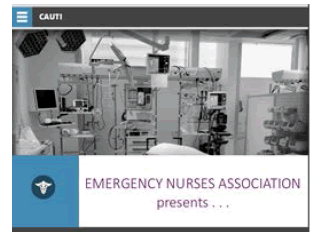
Emergency Nurses Association presents...
Slide 2
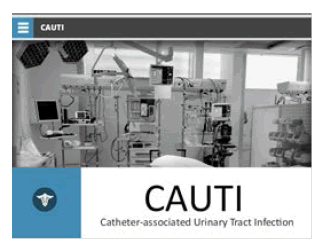
CAUTI: Catheter-associated Urinary Tract Infection
Attribution
Slide 3
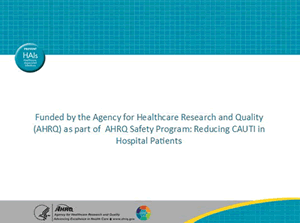
Funded by the Agency for Healthcare Research and Quality (AHRQ) as part of AHRQ Safety Program for Reducing CAUTI in Hospital Patients
Objectives
The objectives of this module are as follows:
- Identify common misconceptions around about the appropriateness of urinary catheter insertion.
- Distinguish between appropriate and inappropriate uses of urinary catheters according to HICPAC, the Health Infection Control Practices Advisory Committee.
- Evaluate current practices in your institution regarding the reduction of catheter-associated urinary tract infections.
- Compare the current practices in your institution to a sample survey of ED nurses.
- Analyze a case study involving decisions around the appropriateness of a urinary catheter and the appropriateness of its removal.
- Formulate talking points to advocate appropriate urinary catheter protocols and decisions.
Introduction
CAUTIs
CAUTIs, catheter-associated urinary tract infections, account for about 35 percent of nosocomial infections. This module will review published recommendations for reducing the number of these infections and includes a discussion of the obstacles uniquely encountered by the emergency department (ED) as practice evolves to incorporate evidence-based recommendations.
Urinary Catheter Utilization
The high incidence of catheter-associated urinary tract infections forces us to accept the urgency in addressing the problem.
Slide 4
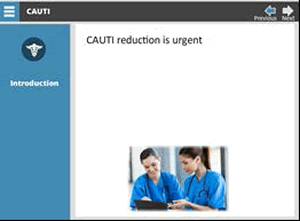
CAUTI reduction is urgent.
Image: Photo of two clinicians talking.
A review of the literature tells us that that the incidence of catheter-associated urinary tract infections can be reduced by using catheters only when necessary, removing them immediately when they are no longer needed, and considering alternatives to indwelling catheterization. Yet the adoption of and adherence to evidence-based protocols varies greatly among institutions.
Slide 5
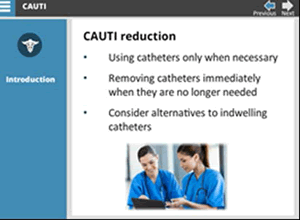
CAUTI reduction
- Using catheters only when necessary
- Removing catheters immediately when they are no longer needed
- Consider alternatives to indwelling catheters.
Urinary catheterization is a common procedure. Up to 25 percent of admitted patients have urinary catheters placed.
The most common areas where patients undergo urinary catheterization are the emergency department, the intensive care unit, and the operating suite.
Because catheter placement is highly prevalent in the emergency department, the emergency nurse can play a significant role in the reduction of CAUTI.
Slide 6
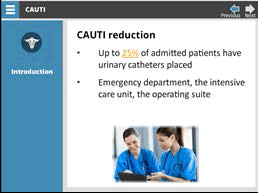
CAUTI reduction
- Up to 25% of admitted patients have urinary catheters placed.
- Emergency department, the intensive care unit, the operating suite.
Reducing CAUTI
The benefits of reducing inappropriate placements of urinary catheters include:
- A reduction in CAUTI rates with decreased catheter use. Avoiding unnecessary procedures will eliminate the risk of infection for those patients. It seems simple, and it is. In many cases, it is not just the UTI that is avoided, but also the more serious risk of urosepsis.
- With decreased infection rates, costs for extended hospitalizations and additional treatments are also decreased.
- With the rise of medication-resistant infections, the use of antibiotics is scrutinized more than ever. Every time we can avoid unnecessary antibiotic use, we reduce risks for our patients.
- Finally, catheters are uncomfortable and the resulting urinary tract infections even more so.
Slide 7

Benefits of reducing inappropriate catheter placements:
Reduced infection rates, costs, antibiotics, and patient discomfort.
Slide 8
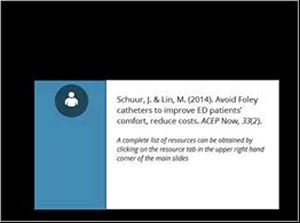
Schuur J, & Lin M. (2014) Avoid Foley catheters to improve ED patients' comfort, reduce costs. ACEP Now. 2014;33(2).
A complete list of resources can be obtained by clicking on the resource tab in the upper right hand corner of the main slides.
Main Menu
This module is divided into three parts. The first part presents traditional practice related to urinary catheter utilization and outlines recommendations for practice change. Part two addresses obstacles to practice change and provides suggestions for removing those obstacles. Part three is a case study that will give you the opportunity to assess a patient, apply the principles you’ve learned, and critically think through the decision-making process to providing the best care.
Slide 9
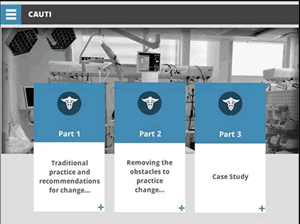
CAUTI
Part 1: Traditional practice and recommendations for change. Part 2: Removing the obstacles to practice change. Part 3: Case Study.
Begin by clicking on part one.
Continue by clicking on part two.
Finish your module by clicking on the case study.



